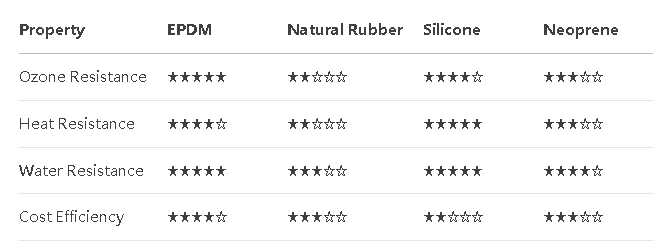
The Unsung Hero Keeping Your Car Dry in Rain: Demystifying EPDM – The “Long-Life Rubber” Powering the Auto Industry
2025/07/10
1. What is EPDM Rubber?
Chemical Identity:
EPDM is a polymer synthesized by copolymerizing ethylene (E), propylene (P), and a small amount of diene monomer (D). Its unique “ternary” structure delivers dual advantages:
Ethylene + Propylene: Forms a backbone resistant to aging and chemical corrosion
Diene Monomer: Introduces crosslinking sites for vulcanization and elasticity
Core Performance Highlights:
Weather Resistance King: Withstands UV rays, ozone, and extreme temperatures (-50°C to 150°C)
Anti-Aging Expert: Service life of 20-30 years
Sealing Guardian: Low gas permeability, high resilience
Eco Champion: Non-toxic, odorless, and recyclable
2. Where You Encounter EPDM Daily
Scenario 1: Automotive Industry’s “Sealing Specialist”
Window Seals: Core barrier against water, noise, and dust
Engine Systems: Coolant hoses and turbocharger pipes (high-temp resistance)
EV Battery Packs: Waterproof seals for high-voltage safety
Sunroof Tracks: UV resistance for decade-long performance
Data: Average car uses 12kg of EPDM, accounting for >40% of all rubber components
Scenario 2: Construction Sector’s “Climate Shield”
Roofing Membranes: Core material for single-ply roofing systems (30-year lifespan)
Curtain Wall Gaskets: Resists wind pressure and thermal expansion
Underground Seals: Ultimate defense against groundwater infiltration
Scenario 3: Household’s “Silent Partner”
Appliance Seals: Washing machine doors, refrigerator gaskets
Sports Surfaces: Eco-friendly track granules
Children’s Toys: Safe elastic components
3. EPDM Evolution: From Basics to Smart Formulations
①Nanotechnology Enhancement
Nanoclay/silica additives increase strength by 50% and double abrasion resistance (used in Tesla Model Y battery seals).
②Green Revolution
Bio-based EPDM: DuPont’s 30% plant-derived monomers
Halogen-Free Flame Retardants: Meets EU RoHS 2.0 standards
Closed-Loop Recycling: Michelin achieves 100% recycled seals
③Smart-Response EPDM
Lab-developed “self-healing EPDM”: Microcapsules release repair agents when damaged (future potential for spacecraft seals).
4. EPDM vs. Other Rubbers: Performance Showdown

Note: EPDM wins overall for weather resistance and value, making it the top choice for outdoor seals
5. Industry Trends: EVs Fueling EPDM Innovation
Electric vehicle growth drives EPDM advancements:
High-Voltage Sealing: Battery packs require 1000V+ resistant seals
Lightweighting: Foamed EPDM density reduced to 0.6g/cm³ (vs. 1.2g/cm³ standard)
Coolant Corrosion Resistance: New glycol coolants accelerate rubber aging
Market Forecast: Global automotive EPDM market to exceed $8 billion by 2025 (Grand View Research)
6. Cool Facts: EPDM’s “Impossible Missions”
Spacecraft Seals: ISS window seals maintain integrity for 20+ years
Undersea Tunnels: Hong Kong-Zhuhai-Macao Bridge joints designed for 120-year service
Polar Exploration: Core material for -60°C Antarctic station seals
Conclusion: The Sustainable Future of an Understated Champion
Over half a century, EPDM has proven true technology lies not in visibility but in reliably solving real-world problems. As global manufacturing turns green, EPDM’s recyclability and longevity make it vital for the circular economy. Next-gen functional EPDM will push performance boundaries, continuing to guard everything from daily life to outer space.
